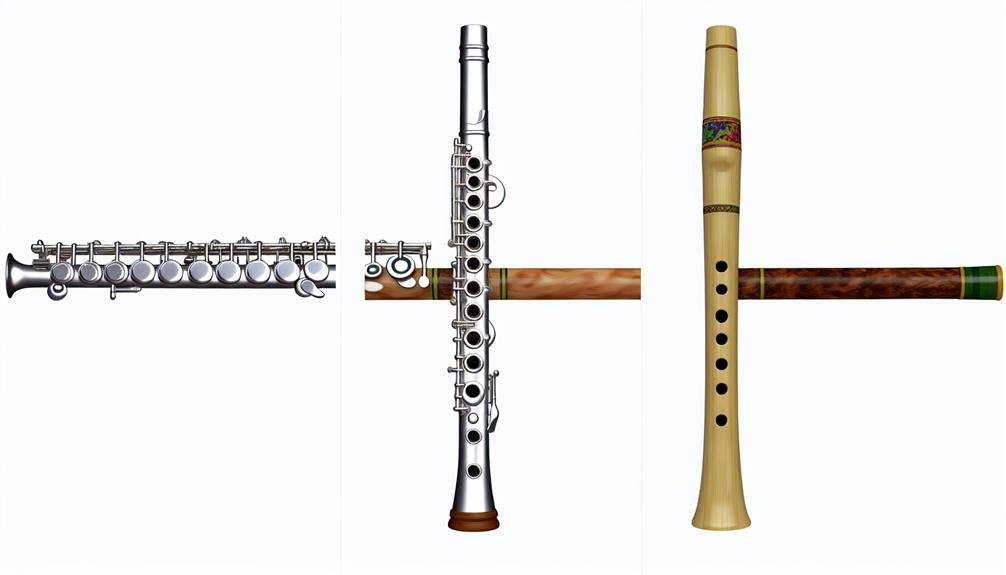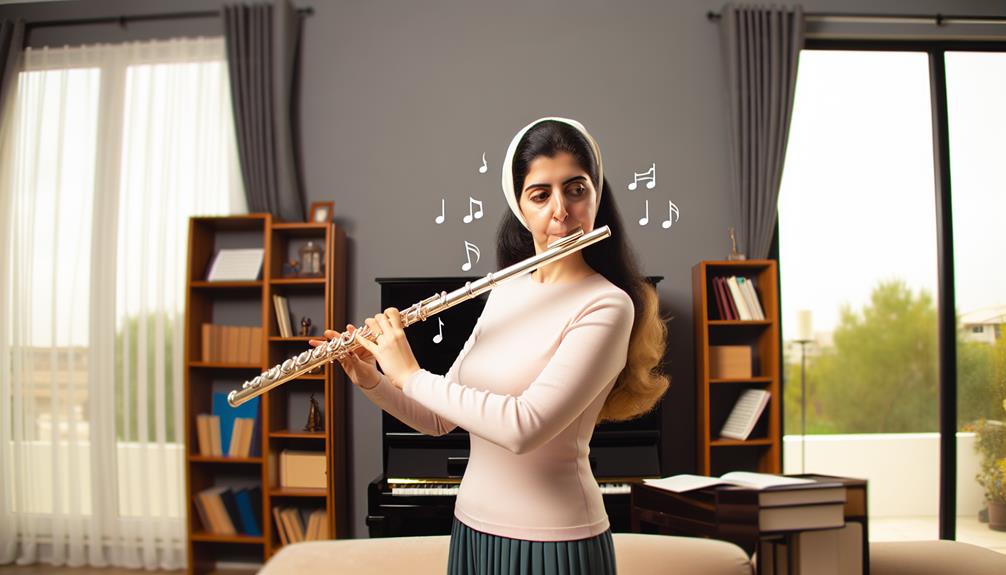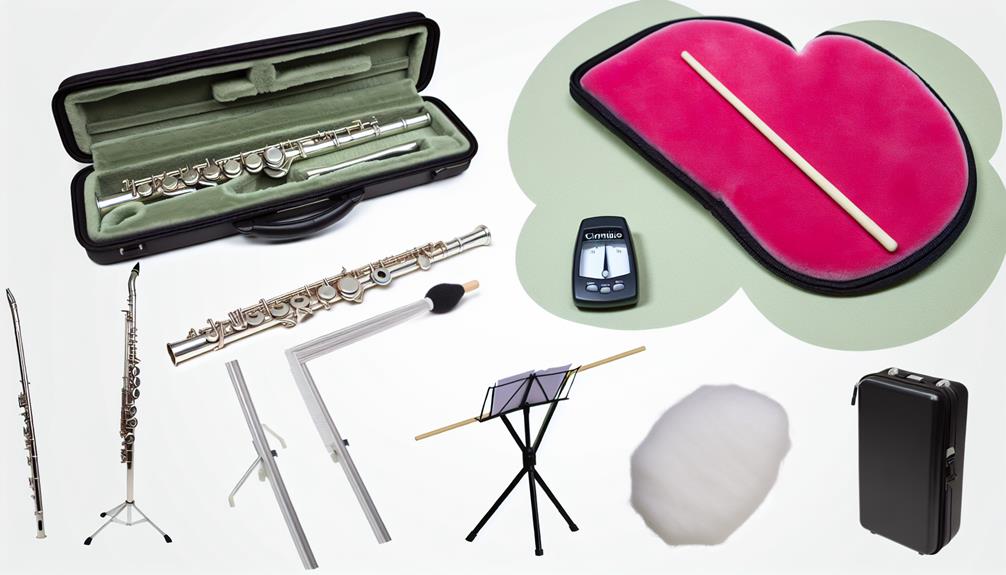The flute, a delicate and melodious instrument, holds a rich history that spans across civilizations and eras, each contributing to its evolution and refinement. From its humble beginnings in ancient times to the intricate designs of the Medieval and Renaissance periods, the flute has undergone significant transformations in both form and function. As we journey through the annals of time, exploring the impact of key innovations and societal influences on this instrument, we begin to uncover a narrative that not only sheds light on its past but also hints at the endless possibilities for its future.
Key Takeaways
- Ancient civilizations crafted early flutes from materials like reed, bamboo, and ivory, showcasing unique designs.
- Flutes in Medieval Europe represented sophistication and status, evolving craftsmanship for better acoustics.
- Baroque era introduced key mechanisms for complex fingerings, influencing music repertoire and playing techniques.
- Modern flute making involves 3D printing and materials like sterling silver, optimizing key mechanisms for balanced sound.
- Contemporary flute music explores new techniques like beatboxing, multiphonics, and electronic effects for versatility.
Ancient Origins of the Flute
The origins of the flute can be traced back to ancient civilizations, where early forms of this instrument were crafted and used in various cultural practices and rituals. Flute construction during these times varied significantly based on the resources available in different regions. Materials such as bone, wood, clay, and even precious metals were used to create flutes with varying shapes and sizes.
In ancient Mesopotamia and Egypt, flutes were constructed from reed or bamboo tubes with holes for the player's fingers to cover and uncover, producing different notes. These early flutes were often played in religious ceremonies and processions, adding a mystical element to the music of the time. The playing techniques involved blowing air into the tube and manipulating finger placements to create melodies.
As civilizations progressed, so did the playing techniques and styles associated with the flute. In ancient Greece, for example, the aulos—a double flute—became a popular instrument in both religious ceremonies and secular events. The Greeks developed complex fingering techniques and embellishments that added depth and emotion to the music played on the flute.
Early Flute Designs
Crafted with meticulous attention to detail and precision, early flute designs showcase a fascinating evolution of craftsmanship and musical ingenuity throughout history. The development of early flutes was shaped by prehistoric flutes made using primitive techniques and cultural variations that gave rise to traditional designs.
- Prehistoric Flutes: The earliest flutes date back to prehistoric times, crafted from materials like bone, wood, and ivory. These flutes were basic in design, with simple holes for producing sound.
- Primitive Techniques: Early flute makers used rudimentary tools and techniques such as carving and drilling to create functional instruments. Despite their simplicity, these flutes laid the foundation for future developments in flute design.
- Cultural Variations: Different cultures around the world began crafting their own versions of flutes, incorporating unique materials and designs reflective of their traditions and beliefs. This led to a rich diversity of flute styles across various regions.
- Traditional Designs: Over time, traditional designs emerged, incorporating intricate carvings, decorations, and embellishments. These designs not only enhanced the visual appeal of the flutes but also played a role in cultural expression and storytelling through music.
The evolution of early flute designs highlights the creativity and resourcefulness of ancient civilizations in creating musical instruments that continue to inspire modern flute makers and musicians alike.
Flute in Medieval Europe
With intricate craftsmanship and cultural influences shaping its development, the flute in Medieval Europe evolved as a symbol of artistic expression and courtly sophistication. During the medieval period, flutes were prominent among musicians in Europe, particularly in courtly settings where they were valued for their delicate tones and versatility. Medieval musicians, often skilled in playing various instruments, incorporated flutes into their performances, adding a touch of elegance and refinement to the music of the time.
The cultural impact of the flute during this era was significant. It was not only a musical instrument but also a symbol of social status and sophistication. Nobles and royalty often patronized musicians who played the flute, further elevating its prestige in medieval society. The flute's ethereal sound captivated audiences and became synonymous with grace and beauty in the aristocratic circles of Medieval Europe.
Furthermore, the craftsmanship of flutes during this period saw advancements, with artisans experimenting with different materials and designs to enhance the instrument's sound quality. The flute gradually evolved from simple wooden pipes to more complex instruments with additional keys and improved acoustics, allowing for greater musical expression.
Renaissance Innovations
How did the Renaissance period contribute to the evolution and innovation of the flute? During the Renaissance, significant advancements in the craftsmanship and techniques surrounding the flute led to notable changes in its design and capabilities. Here are some key aspects that highlight the Renaissance innovations in the development of the flute:
- Introduction of Key Mechanisms: The Renaissance saw the introduction of key mechanisms on flutes, allowing for more complex fingerings and enhanced playability.
- Use of New Materials: Innovations in craftsmanship led to the exploration of new materials for flute making, such as different types of wood and metals, improving the instrument's tone quality and durability.
- Development of Baroque Flutes: The Renaissance period laid the groundwork for the later development of Baroque flutes, with key design elements and playing techniques evolving during this time.
- Refinement of Playing Techniques: Renaissance techniques focused on refining playing techniques, leading to improved control over dynamics and articulation, shaping the way the flute was played for generations to come.
These advancements in Renaissance flute making and playing techniques set the stage for the instrument's continued evolution into the Baroque era, where further innovations would shape its sound and design.
Baroque Era Flute Developments
During the Baroque era, significant advancements in flute design and playing techniques continued to shape the instrument's evolution and sound. The Baroque period saw the refinement of the one-keyed wooden flute, which was the standard flute of the time. These flutes were made of wood, typically boxwood, with a conical bore and a single key to help with tuning. Baroque era techniques, such as articulation, ornamentation, and improvisation, were crucial in shaping the music written for the flute during this period.
Historical influences played a significant role in the development of the flute during the Baroque era. Composers like Johann Joachim Quantz and Georg Philipp Telemann were influential in expanding the repertoire for the flute and developing new playing techniques. Quantz, a renowned flutist and composer, wrote extensively on flute playing methods and contributed to the technical advancements of the instrument.
Modern interpretations of Baroque flute music often involve adapting historical performance practices to contemporary settings. Musicians today use historical instruments or modern replicas to recreate the authentic sound of the Baroque flute. Additionally, performers draw inspiration from historical treatises and recordings to inform their interpretations of Baroque music. The legacy of Baroque flute developments continues to influence flute playing and repertoire to this day.
The Rise of the Modern Flute
The evolution of the modern flute from its Baroque predecessor marked a significant shift in design, materials, and playing techniques, leading to a transformation in sound and performance capabilities. Flute technology underwent substantial advancements during this period, paving the way for modern adaptations that have shaped the instrument's contemporary form and capabilities.
- Cylindrical Bore Design: The transition to a cylindrical bore design in the modern flute allowed for improved intonation and a more focused sound projection.
- Mechanical Key Systems: The integration of complex mechanical key systems enhanced the flute's playability, enabling musicians to navigate through various scales and musical passages with greater ease and precision.
- Materials Innovation: The adoption of materials such as silver, gold, and even platinum in flute construction contributed to a richer tonal quality and increased durability of the instrument.
- Extended Range: Modern flutes were developed with an extended range, enabling musicians to reach higher notes and explore more complex musical compositions with greater versatility.
These advancements in flute technology and modern adaptations not only expanded the expressive capabilities of the instrument but also revolutionized the way flutists approach performance and composition. The rise of the modern flute signifies a pivotal moment in the instrument's history, highlighting the continuous innovation and refinement that have shaped its evolution.
Key Innovations in Flute Making
Significant advancements in flute making have been driven by innovative techniques and materials that have revolutionized the instrument's construction and capabilities. One of the most notable innovations in recent years is the utilization of 3D printing technology. This cutting-edge technique allows for the precise and efficient production of flute components with intricate designs that were previously unattainable through traditional manufacturing methods. 3D printing has enabled flute makers to experiment with new shapes, sizes, and materials, ultimately enhancing the instrument's sound quality and playability.
Another key focus of innovation in flute making has been the exploration of materials to improve the flute's acoustic properties. Manufacturers have been experimenting with different metals, such as sterling silver, gold, and platinum, to create flutes with unique tonal characteristics and improved resonance. By optimizing the composition and thickness of the flute's body and key mechanisms, makers have been able to achieve a more balanced and responsive instrument that offers a wider range of expressive possibilities to musicians.
Flute in Contemporary Music
In the realm of modern music, the flute has evolved to become a versatile and integral instrument, crossing genres and captivating audiences with its unique timbre and expressive capabilities. Flute adaptations and contemporary techniques have propelled this classical instrument into new and exciting territories in contemporary music.
- Extended Techniques: Contemporary flutists have pushed the boundaries of traditional flute playing by exploring a wide range of extended techniques such as beatboxing, multiphonics, flutter-tonguing, and key clicks. These techniques add depth and diversity to the flute's sonic palette.
- Electronic Effects: The use of electronic effects pedals and processors has become increasingly popular among flute players, enabling them to create innovative sounds and textures. This fusion of acoustic and electronic elements has opened up a world of possibilities for flute performance in contemporary music.
- Collaborations with Other Genres: Flutists are collaborating with artists from various genres such as jazz, hip-hop, electronic, and world music. These collaborations have led to the fusion of different styles and the creation of unique and groundbreaking musical works that showcase the flute in a modern context.
- Incorporation in Film and Popular Music: The flute has gained prominence in film soundtracks, pop songs, and even in experimental avant-garde music. Its haunting melodies and agile nature make it a sought-after instrument for composers and musicians looking to add a touch of sophistication and emotion to their music.
Future Trends in Flute Design
Advancements in flute design are poised to revolutionize the instrument's capabilities and enhance the playing experience for musicians across diverse genres. The future of flute design is being shaped by technological advancements and a focus on ergonomic designs to improve playability and comfort for musicians. Sustainability is also a key consideration, leading to innovative material choices that not only benefit the environment but also influence the flute's sound and performance.
To illustrate the future trends in flute design, the following table provides a structured overview:
| Aspect | Description |
|---|---|
| Technological Advancements | Incorporation of advanced materials like carbon fiber to enhance durability and resonance. |
| Ergonomic Designs | Utilizing 3D printing technology to customize key placement for ergonomic comfort and improved finger reach. |
| Sustainability | Exploration of sustainable materials such as recycled plastics or bamboo for eco-friendly and unique flute designs. |
These trends in flute design are not only pushing the boundaries of traditional craftsmanship but also catering to the evolving needs of modern musicians. By embracing technology, ergonomic principles, and sustainable practices, the future of flute design looks promising, offering exciting possibilities for both players and audiences alike.
Frequently Asked Questions
How Did the Flute Impact Indigenous Cultures Around the World?
The flute holds immense cultural significance across indigenous societies globally. It has fostered spiritual connections, often playing a pivotal role in rituals, ceremonies, and storytelling.
The flute's haunting melodies have been a source of unity, conveying emotions and narratives that bind communities together. Its presence has transcended mere musical instrument status, becoming a symbol of heritage and tradition, deeply intertwined with the fabric of indigenous cultures worldwide.
What Role Did the Flute Play in Ancient Religious Ceremonies?
The flute played a significant role in ancient religious ceremonies through its use as a tool for ritual music. Its melodious tones carried symbolic meanings in various cultures, often believed to facilitate communication with the divine.
The flute's association with spirituality and transcendence made it a key instrument in religious rituals, enhancing the ceremonial experience and connecting participants with the sacred. Its use in such contexts highlights the deep cultural significance and reverence attached to the flute.
Are There Any Famous Myths or Legends Involving the Flute?
Flutes hold significant symbolism in various ancient tales and folklore, showcasing their deep cultural significance.
In Greek mythology, the story of Pan and his flute, known as the Pan flute, is a famous example. Pan's musical prowess with the flute captivated listeners and connected him to nature.
Additionally, in Native American folklore, the flute is associated with healing and spiritual ceremonies, highlighting its enduring presence in myths worldwide.
How Has the Flute Been Depicted in Art Throughout History?
Throughout history, the flute has been depicted in various art forms, including paintings, sculptures, and tapestries. These depictions showcase the flute's historical significance as a cultural symbol, often representing themes such as harmony, beauty, and nature.
Artists have skillfully captured the essence of the flute, highlighting its cultural significance and the emotional impact it has had on societies worldwide. These artistic representations serve as a testament to the flute's enduring legacy and cultural importance.
What Are Some Unique Regional Variations of the Flute?
Regional styles of the flute exhibit diverse cultural influences, resulting in a rich tapestry of musical traditions. From the haunting melodies of the Native American flute to the intricate fingerings of the Japanese shakuhachi, each variation reflects the unique musical expressions of its region.
The Irish tin whistle's lilting tunes contrast with the bold sounds of the Andean quena, showcasing the versatility and adaptability of this ancient instrument.
Conclusion
In conclusion, the history and evolution of the flute showcase a remarkable journey from ancient civilizations to modern interpretations.
Through intricate designs and advancements in craftsmanship, the flute has symbolized sophistication and innovation throughout the ages.
From the early reed and bamboo flutes to the modern use of advanced materials and technology, the flute continues to captivate audiences with its rich history and timeless elegance, making it a truly iconic instrument in the world of music.





